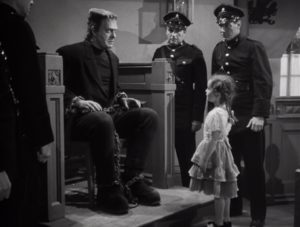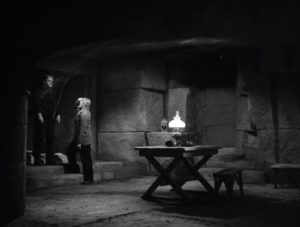Technical Specs
Director: Erle C. Kenton
Writer: W. Scott Darling
Cast: Sir Cedric Hardwicke, Ralph Bellamy, Lionel Atwill, Bela Lugosi, Evelyn Ankers, Janet Ann Gallow, Barton Yarborough, Doris Lloyd, Leyland Hodgson, Olaf Hytten, Holmes Herbert, and Lon Chaney
Composer: H.J. Salter
Release Date: 3/13/1942
MPAA Rating: Not Rated
Overview
After Castle Frankenstein is demolished by a horde of angry villagers, the Monster (Lon Chaney) emerges from his sulfuric grave and accompanies Ygor—now alive and  well despite having been shot numerous times by Wolf Frankenstein—to Visaria, where Ludwig Frankenstein (Sir Cedric Hardwicke) resides with his daughter Elsa (Evelyn Ankers). Prompted by Ygor to pursue the scientific endeavors that motivated his father and brother before him, Ludwig agrees to make the Monster well again; but under one condition: the brain of Ludwig’s deceased lab assistant, Dr. Kettering (Barton Yarborough), must replace that with which Henry Frankenstein originally endowed his creation. Ygor agrees to the above terms, but only after convincing the disgraced Doctor Bohmer (Lionel Atwill) to switch Kettering’s brain with his own.
well despite having been shot numerous times by Wolf Frankenstein—to Visaria, where Ludwig Frankenstein (Sir Cedric Hardwicke) resides with his daughter Elsa (Evelyn Ankers). Prompted by Ygor to pursue the scientific endeavors that motivated his father and brother before him, Ludwig agrees to make the Monster well again; but under one condition: the brain of Ludwig’s deceased lab assistant, Dr. Kettering (Barton Yarborough), must replace that with which Henry Frankenstein originally endowed his creation. Ygor agrees to the above terms, but only after convincing the disgraced Doctor Bohmer (Lionel Atwill) to switch Kettering’s brain with his own.
 Operating on the absurd premise that an 800 °F sulfur pit would “preserve” the Monster, this installment earns its reputation as the first of many B-grade Frankenstein films produced by Universal Studios. Horror buffs may nevertheless enjoy The Ghost of Frankenstein for its atmospheric qualities, whereas Bela Lugosi fans will certainly appreciate the late actor’s sinister reprisal of Ygor.
Operating on the absurd premise that an 800 °F sulfur pit would “preserve” the Monster, this installment earns its reputation as the first of many B-grade Frankenstein films produced by Universal Studios. Horror buffs may nevertheless enjoy The Ghost of Frankenstein for its atmospheric qualities, whereas Bela Lugosi fans will certainly appreciate the late actor’s sinister reprisal of Ygor.
Pros
In contrast to Basil Rathbone’s scenery-chewing performance in Son of Frankenstein, Sir Cedric Hardwicke’s acting exemplifies the level of dignity that one  would expect of a seasoned medical practitioner. Particularly commendable is the fact that Ludwig maintains his poise even when compelled by an apparition of his late father to restore the Monster’s health, an event that could understandably perturb an otherwise stable man of science. There are times when the Ludwig character would have benefited from a more enthusiastic manner, such as when the good doctor (supposedly) succeeds in restoring the brain of Kettering; that being said, an overall calm demeanor prevents Ludwig from overshadowing Lugosi’s portrayal of Ygor—the true villain in yet another ostensible mad scientist narrative.
would expect of a seasoned medical practitioner. Particularly commendable is the fact that Ludwig maintains his poise even when compelled by an apparition of his late father to restore the Monster’s health, an event that could understandably perturb an otherwise stable man of science. There are times when the Ludwig character would have benefited from a more enthusiastic manner, such as when the good doctor (supposedly) succeeds in restoring the brain of Kettering; that being said, an overall calm demeanor prevents Ludwig from overshadowing Lugosi’s portrayal of Ygor—the true villain in yet another ostensible mad scientist narrative.
Cons
(Spoilers beyond this point)
 Despite failing to emulate the animated mannerisms, primitive growling noises, and pyrophobic tendencies embodied by Boris Karloff, Lon Chaney nonetheless conveyed a childlike simplicity to complement the imposing stature and misshapen countenance for which the Monster is known. Unfortunately, any nuance provided by Chaney will no doubt be forgotten by the film’s climax, which, though fascinating on paper, suffers from an unintentionally humorous execution. By dubbing Chaney’s voice with that of Lugosi following the Monster’s brain transplant, The Ghost of Frankenstein’s finale forgoes the tense atmosphere that characterized prior sequences and will likely amuse rather than terrify all but the most serious of fans.
Despite failing to emulate the animated mannerisms, primitive growling noises, and pyrophobic tendencies embodied by Boris Karloff, Lon Chaney nonetheless conveyed a childlike simplicity to complement the imposing stature and misshapen countenance for which the Monster is known. Unfortunately, any nuance provided by Chaney will no doubt be forgotten by the film’s climax, which, though fascinating on paper, suffers from an unintentionally humorous execution. By dubbing Chaney’s voice with that of Lugosi following the Monster’s brain transplant, The Ghost of Frankenstein’s finale forgoes the tense atmosphere that characterized prior sequences and will likely amuse rather than terrify all but the most serious of fans.
Analysis
Having come full circle in Bride of Frankenstein, the Monster is now reduced to a mindless brute in order for the primary focus to remain on Ygor, Ludwig, and Doctor Bohmer at all times. In spite of this, The Ghost of Frankenstein does not altogether deprive its titular  Monster of those human qualities which allowed audiences to sympathize with him in previous outings. Viewers of a sensitive inclination will, for instance, be moved by the influence that Cloestine Hussman (Janet Ann Gallow)—a sweet, unassuming child from the village of Visaria—apparently has over her lumbering companion. The chemistry between Cloestine and Frankenstein’s creature becomes especially relevant in later scenes, during which the Monster shows an obvious preference for the company of an innocent child over that of Ygor, whose fiendish attempts to guide his “friend” have only ever resulted in murder, mayhem, and lasting anguish for those foolish enough to stand in his path.
Monster of those human qualities which allowed audiences to sympathize with him in previous outings. Viewers of a sensitive inclination will, for instance, be moved by the influence that Cloestine Hussman (Janet Ann Gallow)—a sweet, unassuming child from the village of Visaria—apparently has over her lumbering companion. The chemistry between Cloestine and Frankenstein’s creature becomes especially relevant in later scenes, during which the Monster shows an obvious preference for the company of an innocent child over that of Ygor, whose fiendish attempts to guide his “friend” have only ever resulted in murder, mayhem, and lasting anguish for those foolish enough to stand in his path.
Concluding Comments
 The Ghost of Frankenstein is a worthy final chapter in Universal Studios’ saga of standalone Frankenstein features. Though illogical at times and downright laughable at others, this offering should be viewed as an entertaining, if not terribly substantive, conclusion to the story arc initiated by James Whale’s 1931 masterpiece (subsequent films would expand upon the adventures of Larry Talbot/The Wolf Man, Dracula, and an assortment of generic mad scientists over those of the Monster, who, from this point forward, continues to exist only as a laboratory prop and not the dynamic character that Whale intended him to be).
The Ghost of Frankenstein is a worthy final chapter in Universal Studios’ saga of standalone Frankenstein features. Though illogical at times and downright laughable at others, this offering should be viewed as an entertaining, if not terribly substantive, conclusion to the story arc initiated by James Whale’s 1931 masterpiece (subsequent films would expand upon the adventures of Larry Talbot/The Wolf Man, Dracula, and an assortment of generic mad scientists over those of the Monster, who, from this point forward, continues to exist only as a laboratory prop and not the dynamic character that Whale intended him to be).
Overall Quality: 7/10
If you enjoyed this post, please click the follow button or enter your email address in the subscription box to stay tuned for more updates.
